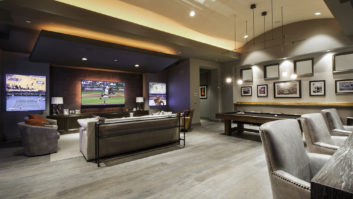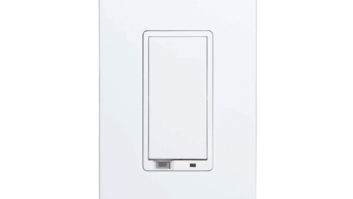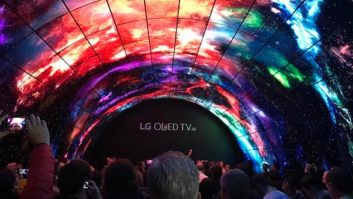In today’s cost- and environmentally conscious world, it’s important to know as much as possible about the light sources used in current flat-panel video displays, before specifying a system for your client.
BACKGROUND ON BACKLIGHT
When it comes to flat-panel displays, remember that plasma and OLED are emissive technologies, where each pixel is addressed individually, generating its own light without the need for an external source. That means they are turned on or off, making it possible to achieve higher contrast; when a pixel is off, it really is off. With LCD, on the other hand, the individual pixels act as light gates so that when they are “on,” light passes through the pixel, and when it is “off,” it does not.
The light in question has to come from an external source, which until recently mostly has been a cold-cathode fluorescent lamp (CCFL). CCFLs are a reliable and proven technology, and they certainly have done a great job in providing illumination for the vast majority of LCD screens sold to date. They are affordable, produce reasonably even light when used with a proper diffuser, and have a decent life span. With improvements in the coatings inside the lamps and other aspects of their technology, the color gamut also has been improved for better picture quality.

Sharp’s LC-52LE700UN LCD features LED backlight technology.
It is worth noting that some brands utilize HCFL bulbs, where the “H” stands for “hot” instead of cold. Although the technology is somewhat different from HCFL to CCFL, the results are the same. As you and your clients scan the manufacturers’ ads and spec sheets you will also see a variety of other attributes associated with the type of bulb used, including technologies and processes that improve the gamut of the light and the bulb’s use as part of a system that reduces power consumption. The impact of the specifics of the bulb used will vary from brand to brand, and even from model to model within a brand. You can gauge some of the impact from looking at the specs, but at the end of the day some of the differences may only be determined by a side-byside comparison.
For all their strong points, regardless of bulb type and technology, fluorescents are far from perfect. Thanks to the presence of mercury inside the tubes, there are issues with hazardous materials at disposal time. Further, while “cold” is part of the CCFL name, that is more of a technical appellation than an exact description. While they do run cooler than PDPs, they are still a heat source, and heat is the enemy of any electronics.
When you see the letters “CFL,” regardless of whether they are preceded by an “H” or by a “C” (as will be the case for most displays), there is a natural leap to “CFL,” or “compact fluorescent lamp,” those squiggly bulbs touted as an energy-saving light source. That is true for CFL, and while a CCFLbased LCD display may use less energy than a similarly sized PDP, it can still be a bit of an energy hog. Finally, as anyone who has replaced incandescent or halogen bulbs with CFLs knows, fluorescent light sources don’t take well to dimming. Even if dimmable CCFLs were in the mix, their large size and by extension the large area behind an LCD panel that they cover would make it difficult to selectively dim small areas of a screen. Think back for a minute to the notion that LCDs are light gates, and imagine that the gates don’t shut completely and let some light through even when they are supposed to be shut. That is why LCDs are sometimes dark gray when they should be totally black, lowering contrast.
BENEFITS OF AN LED LIGHT SOURCE
All of the above are issues that LEDs begin to address to one degree or another when chosen as backlight source. A few of the basic issues are taken care of in any LED-illuminated system. Others are remedied in some designs, but not all.
For example, LEDs have a considerably greater life span than CCFLs, sometimes as much as twice that as a CCFL and perhaps more when you consider the half-life brightness figure of a CCFL rather than its total life. Therefore, an LED-based display, while costing more today, should last longer. Further, the elimination of mercury means that hazardous materials issues are reduced, though not totally eliminated. We say that because although there may be materials rated as hazardous within LEDs, they are encapsulated so that disposal is not a problem.3
Given that LEDs are often touted as being energy efficient, one would expect them to consume less energy than an LCD display of identical size. In some cases that is true, such as one brand where a new full-array white LED model drops the power consumption for a 52-inch display to 250 watts, which is a 40-watt reduction from a CCFL model of the same size. That’s a 14-percent reduction. However, with advances in the implementation of bulbs into the total system for a display, the results are not always that favorable.
Another brand’s mid-line 46-inch class LCD consumes 245 watts, but models with an “eco” chassis design drop the power requirement to only 160 watts. Switch to the same brand’s LED-lit model with a full RGB backlit array, and the power consumption doesn’t decrease, it actually increases to 350 watts, more than twice that of the “eco-set.” Similarly, their edge-lit LED model consumes 180 watts, the standard chassis and bulb draws 165 watts, and the “eco” model cuts power consumption to 140 watts.
Power consumption for an LED model versus a conventional CCFL model clearly varies within and between brands, so you should look before you leap, and resist the natural temptation to pitch an LED-based model as consuming less power unless you are on firm ground with the model you are proposing.
LED WINS THE THIN BATTLE
So far we’ve made a few nice arguments for LED illumination, but nothing terribly compelling and certainly nothing that solidly justifies the price premiums currently associated with LEDs. As you dig further, though, things get interesting.
While we’ve heard it said that “No one ever complained that their flatpanel display was too thick,” thin is definitely in, and combining thin with lighter weight and potentially lower power consumption does begin to build the case. Here is where the differences between the types of LED illumination systems also begin to figure into the picture.
Although CCFLs have been used for years to light up laptop displays, which by definition need to be very thin, there is a limit to how much you can “squish” them down. To get the thinnest LCD sets, the LEDs are used in what is known as an “edge-lit” configuration where white LEDs are placed along the edge of the screen and their light is spread across the back of the LCD panel through a diffuser. Placing the light source at the edges of the screen and using a thin diffusion panel is part of how the front-to-back depth is dramatically reduced. Add in more compact electronics and you get the thin screens that are all the rage in design circles.
As an alternative to edge-lit designs, the next step up is what you will see referred to as a “full array” design. Here, in place of LEDs at the edge of the screen, a greater number of devices are spread across the back of the screen, just as a CCFL is behind the screen. More LEDs are used, but the result is a more evenly lit picture.
In a perfect world, the LEDs would be small enough to allow an individual LED behind every pixel, but when you do the math and calculate the number of pixels in a 1920 x 1080 display you will quickly realize that an LED under every pixel would be impractical and certainly not something that just anyone could afford.
At this point in time, most of the full-array designs use white LEDs. At the high end of LED-based displays, some displays have used individual RGB LEDs. This enables more precise color rendition, but again, remember that these are arrays, not a discrete LED behind each pixel.
LOCAL DIMMING
So they have made the screen thinner, made it last longer, and in some cases cut the power consumption. But to make them really work, these displays have to overcome the advantage that pixel-based illumination sets have in being able to turn any cell on or off. That’s where local dimming comes into play.
Remember, where bulbs can be flashed on or off, they light the entire screen at once. Of course, LEDs also can be switched on and off, almost instantly with little or no decay time. Things really begin to cook when you take that ability one step further and add circuitry that can either switch LEDs on or off in one area of the screen or dim them in a certain area of the screen but not another.
This is called local dimming, or modulation, depending on the brand and specific technology implementation, and it makes it possible to deliver LCD displays that offer seven-figure contrast ratios that rival those of competing display technologies. As an added benefit, the ability to localize the on or off state of individual LEDs, or LED groupings, will also make the set more energy efficient, as power is only needed when an LED is on.
At this point it should be noted that while all local dimming displays are full-array, not all full-array displays offer local dimming. This may become one of those spec sheet items that you will want to pay special attention to. Keep in mind that there is not a discrete LED behind every pixel. Therefore, as the use of full-array LED fields becomes more commonplace, it will be interesting to see if display manufacturers begin to quote the number of LEDs in their displays and the number of dimming zones.
Displays with higher LED counts will likely cost more, but at least now you’ll know what the benefit is and be able to explain the advantages of higher contrast and lower energy consumption available at higher initial cost.
LED VS. OLED
Even with that, as is all too common in an industry such as ours that is rooted in fast-changing technology, it is probable that you will be asked how this all stacks up against OLED. For the moment, the question is somewhat moot. Despite demonstrations of large-size OLED displays, Sony’s 11-inch model remains the only one available in North America at this time. That may change this year with LG’s announcement of a 15-inch set this year, to be followed by larger sizes going forward into the next two to three years. Other companies such as Samsung and Sony have also demonstrated large-screen OLED prototypes, but whether or not they can be brought to market at affordable prices with life spans that are in line with what will likely be high initial pricing remains to be seen.
That said, one interesting application that has been floated for OLED is to use white OLEDs as a backlight for LCD sets. Presuming the cost and technology issues work out, this hybrid approach has appeal as a “best of both worlds” mix.
Is it all worth it? Unless you are ready to cede your display business to others, we believe it is. LED-based LCD screens aren’t the answer to everything, and it will be some time before the technology spreads to all screen sizes. What it does do is provide one more weapon with which to fight price erosion. More importantly, it gives you and your sales and design teams the ability to show your clients that your firm not only knows which technology to use in a given part of a system, but is able to explain the reason behind the choice. That, regardless of the cost of the product or the total figure on the bid, is priceless.
The LED’s ability to be instantly turned on and off, combined with its small physical size, enables precise control of where the light strikes the LCD. With Dolby Vision, the LEDs are controlled to produce the required intensity of light on the pixels they are positioned behind. This local control produces a dynamic range of luminance that is orders of magnitude greater than is possible with current CCFL LCD panels, resulting in a far more realistic image.
Los Angeles-based Michael Heiss ([email protected]) is a contributing editor for Residential Systems







